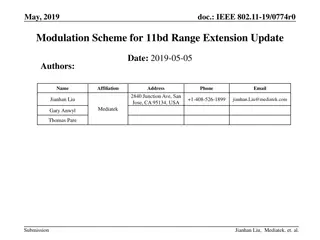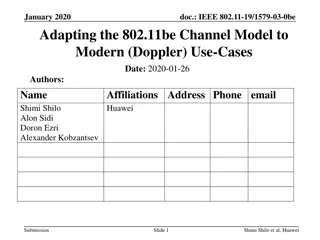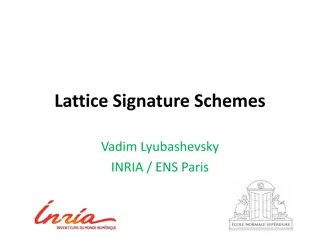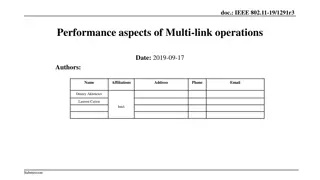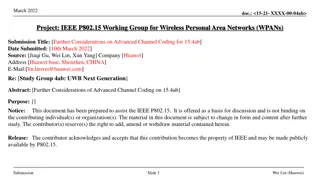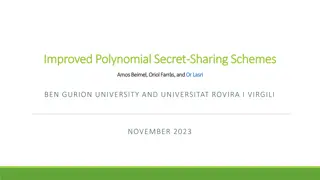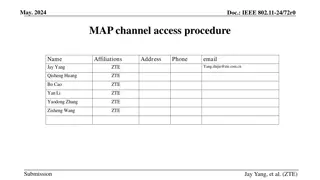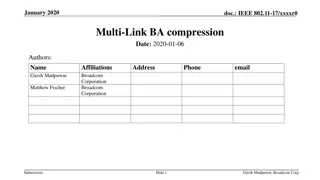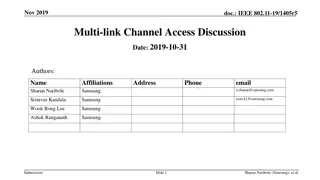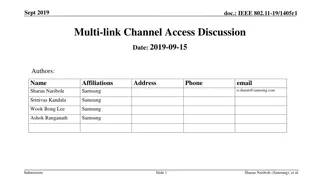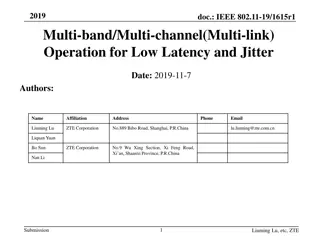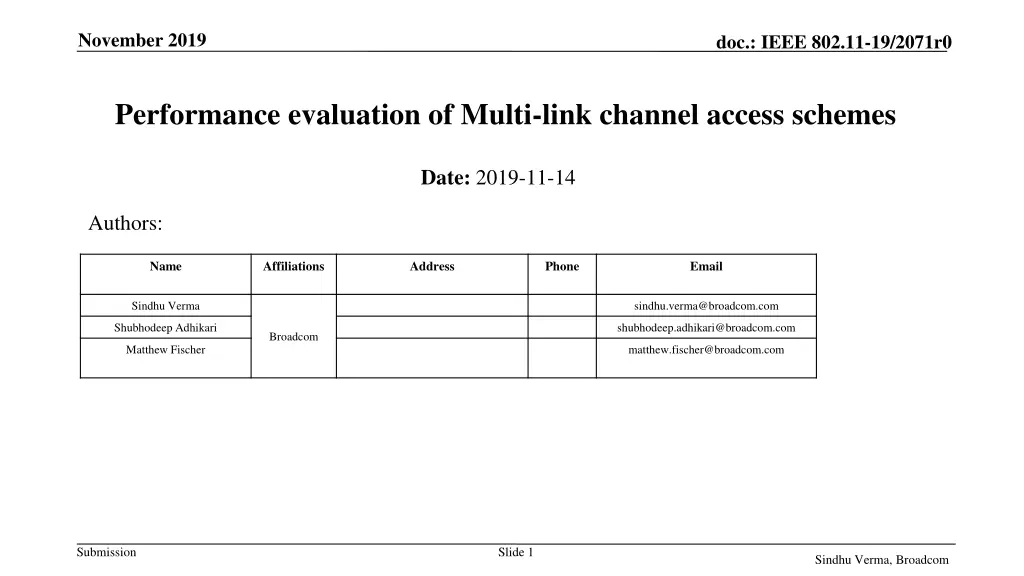
Performance Evaluation of Multi-link Channel Access Schemes in IEEE 802.11-19/2071r0
This document discusses the impact of channel access schemes on latency and outage in multi-link operation, comparing them with single-link performance. It explores the benefits of multi-link operation in enhancing throughput and latency, highlighting factors affecting performance improvement such as scheduling decisions, channel access schemes, and TID distribution. Simulation results and setup configurations are also presented.
Download Presentation

Please find below an Image/Link to download the presentation.
The content on the website is provided AS IS for your information and personal use only. It may not be sold, licensed, or shared on other websites without obtaining consent from the author. If you encounter any issues during the download, it is possible that the publisher has removed the file from their server.
You are allowed to download the files provided on this website for personal or commercial use, subject to the condition that they are used lawfully. All files are the property of their respective owners.
The content on the website is provided AS IS for your information and personal use only. It may not be sold, licensed, or shared on other websites without obtaining consent from the author.
E N D
Presentation Transcript
November 2019 doc.: IEEE 802.11-19/2071r0 Performance evaluation of Multi-link channel access schemes Date: 2019-11-14 Authors: Name Affiliations Address Phone Email Sindhu Verma sindhu.verma@broadcom.com Shubhodeep Adhikari shubhodeep.adhikari@broadcom.com Broadcom Matthew Fischer matthew.fischer@broadcom.com Submission Slide 1 Sindhu Verma, Broadcom
November 2019 doc.: IEEE 802.11-19/2071r0 Abstract This contribution discusses the impact of channel access schemes used for multi-link operation on the user perceived metrics of latency and outage. Using single-link performance as baseline, it also tries to quantify the gains of multi-link operation over single- link operation depending on the channel access schemes used. Submission Slide 2 Sindhu Verma, Broadcom
November 2019 doc.: IEEE 802.11-19/2071r0 Background Multi-link operation in 11be can enhance throughput and latency performance by enabling simultaneous access to non-contiguous channels in the unlicensed spectrum Theoretically, the benefit comes from diversity and trunking efficiency Other standardization forums such as 3GPP (starting HSDPA and continuing to LTE/NR) have also studied performance gains in a similar context; for example, the gain due to simultaneous access to 2 channels over 2 times access to a single channel [1]. The quantum of performance improvement depends on many factors like the dynamism of scheduling decisions on different channels, the channel access schemes, the split of TIDs into channels and asynchronous/synchronous operation. In the following slides, we present results from simulations that attempt to capture some of the factors Submission Slide 3 Sindhu Verma, Broadcom
November 2019 doc.: IEEE 802.11-19/2071r0 Simulation setup and configuration (1) 8 nodes: 4 VO flows (24 Kbps CBR, 60 bytes packet size each) and 4 BE flows (10 Mbps CBR, 1500 bytes packet size each) per node. Total number of channels available = 4 (Each with a 200 Mbps capacity). All nodes have the same PHY data rate of 200 Mbps per channel No hidden nodes. Maximum aggregation of 64 is assumed. However, no limitation in sequence number availability is assumed due to simultaneous transmission on multiple channels. This would be the case if the BA window size is increased suitably. Any flow can use any channel that the node is operating on (akin to Low MAC split) No channel errors. Only packet errors are due to collisions. Collisions are modelled as errors in RTS (each TXOP starts with RTS/CTS exchange). Hence, the effect of collisions is less pronounced in data throughput. The effect would be worsened if whole TXOPs collide. 10 iterations and 5 seconds for each iteration. Submission Slide 4 Sindhu Verma, Broadcom
November 2019 doc.: IEEE 802.11-19/2071r0 Simulation setup and configuration (2) Channel access cases evaluated: Asynchronous Full backoff on all channels: Multi-link: 4 channels per node Single-link: 1 channel per node chosen randomly Asynchronous Full backoff on all channels but synchronous Tx/Rx due to synchronous Receiver: Multi-link: 4 channels per node. Asynchronous Full backoff on 1 channel and PIFS backoff on the remaining but synchronous Tx/Rx due to Synchronous Receiver : Multi-link : 4 channels per node: Full backoff channel selected randomly. Multi-link: 4 channels per node: Each channel has exactly 2 nodes that perform Full backoff on it. Multi-link: 4 channels per node: Full backoff channel is the same for all the 8 nodes. Single-link: 1 channel per node chosen such that there are 2 nodes on each channel: i.e. there is no channel that has PIFS backoff a(ii) and c(iv) are to provide baseline in the form of single-link performance. Note: The restrictions on asynchronous operation are due to constraints of synchronous operation on the receiver side. So, in the current simulations, it is assumed the 2 channels can be independently sensed by the transmitting device and there is no spillage of energy from transmission of one channel on to another. Hence, if another channel becomes free while transmission is ongoing on one channel, the device can perform EDCA independently on the other channel Slide 5 a. i. ii. b. i. c. i. ii. iii. iv. Submission Sindhu Verma, Broadcom
November 2019 Results: Voice Latency and Outage doc.: IEEE 802.11-19/2071r0 The figure on the left shows a CDF of voice packet latencies and outage over all flows, clients and iterations for each scheme. Outage ratio for a flow is defined here as ratio the number of packets not served to the number of packets that have arrived for the flow It shows that PIFS-based multi-link channel access schemes have poor performance if the PIFS channels of nodes coincide with full backoff channels of other nodes. The performance of such PIFS based schemes is so poor that it is similar to single link performance with proportionately smaller number of nodes i.e. the diversity and trunking gain of multi-link operation is not achieved in such cases. The only case where PIFS-based multi-link channel access achieves good performance is when the full backoff channel for all the nodes is the same It also shows that the schemes where full backoff is performed over all channels, performance. show similar Submission Slide 6 Sindhu Verma, Broadcom
November 2019 Results: Best Effort Latency and Outage doc.: IEEE 802.11-19/2071r0 The figure on the left shows a CDF of voice packet latencies and outage over all flows, clients and iterations for each scheme. Outage ratio for a flow is defined here as ratio the number of packets not served to the number of packets that have arrived for the flow Similar to the data for Voice, it shows that PIFS- based multi-link channel access schemes have poor performance if the PIFS channels of nodes coincide with full backoff channels of other nodes. The performance of such PIFS based schemes is so poor that it is similar to single link performance with proportionately smaller number of nodes i.e. the diversity and trunking gain of multi-link operation is not achieved in such cases. The only case where PIFS-based multi-link channel access achieves good performance is when the full backoff channel for all the nodes is the same It also shows that the schemes where full backoff is performed over all channels, performance. show similar Submission Slide 7 Sindhu Verma, Broadcom
November 2019 doc.: IEEE 802.11-19/2071r0 Conclusions The results here corroborate the intuition that if quantifiable performance X is achieved with a single-link operation, with efficient multi-link operation over N links, the performance achieved can be significantly better than NX. This quantifiable performance can be in terms of the latency/outage on a fixed number of flows or users per bandwidth or in terms of number of flows or users per bandwidth that can be supported with the same latency/outage characteristics. With uncoordinated and mismatched PIFS-based channel access, the gains of multi-link operation can be completely lost. Hence, PIFS-based channel access is recommended only if it can be ensured that full backoff and PIFS channels of different nodes do not coincide. Next Steps: More complex scenarios with nodes of different number of channels and asynchronous/synchronous assumptions, Link adaptation The effect of leakage from transmission on one channel on to another needs along with any associated decisions on transmission, Tx power and MCS adjustment. Load variation Submission Slide 8 Sindhu Verma, Broadcom
References November 2019 doc.: IEEE 802.11-19/2071r0 [1] 3GPP TR 25.825, Dual-Cell HSDPA operation Submission Slide 9 Sindhu Verma, Broadcom




